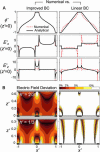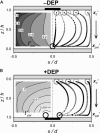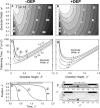Geometric and material determinants of patterning efficiency by dielectrophoresis
- PMID: 15454417
- PMCID: PMC1304640
- DOI: 10.1529/biophysj.104.039511
Geometric and material determinants of patterning efficiency by dielectrophoresis
Abstract
Dielectrophoretic (DEP) forces have been used extensively to manipulate, separate, and localize biological cells and bioparticles via high-gradient electric fields. However, minimization of DEP exposure time is desirable, because of possible untoward effects on cell behavior. Toward this goal, this article investigates the geometric and material determinants of particle patterning kinetics and efficiency. In particular, the time required to achieve a steady-state pattern is theoretically modeled and experimentally validated for a planar, interdigitated bar electrode array energized in a standing-wave configuration. This measure of patterning efficiency is calculated from an improved Fourier series solution of DEP force, in which realistic boundary conditions and a finite chamber height are imposed to reflect typical microfluidic applications. The chamber height, electrode spacing, and fluid viscosity and conductivity are parameters that profoundly affect patterning efficiency, and optimization can reduce electric field exposure by orders of magnitude. Modeling strategies are generalizable to arbitrary electrode design as well as to conditions where DEP force may not act alone to cause particle motion. This improved understanding of DEP patterning kinetics provides a framework for new advances in the development of DEP-based biological devices and assays with minimal perturbation of cell behavior.
Copyright 2004 Biophysical Society
Figures








Similar articles
-
Basic theory of dielectrophoresis and electrorotation.IEEE Eng Med Biol Mag. 2003 Nov-Dec;22(6):33-42. doi: 10.1109/memb.2003.1304999. IEEE Eng Med Biol Mag. 2003. PMID: 15007989 No abstract available.
-
Modeling of dielectrophoretic particle motion: Point particle versus finite-sized particle.Electrophoresis. 2017 Jun;38(11):1407-1418. doi: 10.1002/elps.201600461. Epub 2017 Feb 23. Electrophoresis. 2017. PMID: 28164365
-
Dual frequency dielectrophoresis with interdigitated sidewall electrodes for microfluidic flow-through separation of beads and cells.Electrophoresis. 2009 Mar;30(5):782-91. doi: 10.1002/elps.200800637. Electrophoresis. 2009. PMID: 19197906
-
Electrical forces for microscale cell manipulation.Annu Rev Biomed Eng. 2006;8:425-54. doi: 10.1146/annurev.bioeng.8.061505.095739. Annu Rev Biomed Eng. 2006. PMID: 16834563 Review.
-
Dielectrophoretic separation of bioparticles in microdevices: a review.Electrophoresis. 2014 Mar;35(5):691-713. doi: 10.1002/elps.201300424. Epub 2014 Feb 4. Electrophoresis. 2014. PMID: 24338825 Review.
Cited by
-
Numerical Study of Joule Heating Effects on Microfluidics Device Reliability in Electrode Based Devices.Materials (Basel). 2021 Oct 5;14(19):5819. doi: 10.3390/ma14195819. Materials (Basel). 2021. PMID: 34640216 Free PMC article.
-
Puncture mechanics of cnidarian cnidocysts: a natural actuator.J Biol Eng. 2009 Sep 28;3:17. doi: 10.1186/1754-1611-3-17. J Biol Eng. 2009. PMID: 19785761 Free PMC article.
-
Virus enrichment for single virus infection by using 3D insulator based dielectrophoresis.PLoS One. 2014 Jun 11;9(2):e94083. doi: 10.1371/journal.pone.0094083. eCollection 2014. PLoS One. 2014. PMID: 24918921 Free PMC article.
-
Direct assembling methodologies for high-throughput bioscreening.Biotechnol J. 2011 Dec;6(12):1454-65. doi: 10.1002/biot.201100100. Epub 2011 Oct 21. Biotechnol J. 2011. PMID: 22021162 Free PMC article. Review.
-
The use of electric fields in tissue engineering: A review.Organogenesis. 2008 Jan;4(1):11-7. doi: 10.4161/org.5799. Organogenesis. 2008. PMID: 19279709 Free PMC article.
References
-
- Abbott, A. 2003. Biology's new dimension. Nature. 424:870–872. - PubMed
-
- Albrecht, D. R., R. L. Sah, and S. N. Bhatia. 2002. Dielectrophoretic cell patterning within tissue engineering scaffolds. IEEE Proceedings of the Second Joint EMBS/BMES Conference 2:1708–1709.
-
- Archer, S., T. T. Li, A. T. Evans, S. T. Britland, and H. Morgan. 1999. Cell reactions to dielectrophoretic manipulation. Biochem. Biophys. Res. Commun. 257:687–698. - PubMed
-
- Arnold, W. M., and U. Zimmermann. 1988. Electro-rotation: development of a technique for dielectric measurements on individual cells and particles. Journal of Electrostatics. 21:151–191.
Publication types
MeSH terms
Substances
LinkOut - more resources
Full Text Sources
Other Literature Sources

